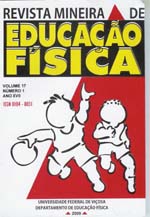EFEITO AGUDO DO EXERCÍCIO AERÓBICO INTERMITENTE NO ESTRESSE OXIDATIVO DE MULHERES JOVENS E DE MEIA IDADE
Keywords:
intermittent exercise, oxidative stress, trained womenAbstract
Exercise of high intensity and long duration can lead to an imbalance between pro and antioxidant systems, causing damage to proteins, DNA and the lipid layer of the cell membrane. This study aimed to evaluate the oxidative stress parameters after a session of intermittent aerobic exercise. The study included 32 women divided into four groups: young trained (n8) with 29.0 ± 3.5 of age, middle-aged trained women (n9) at 48.8 ± 3.8 years old, sedentary young (n9 ) with 25.4 ± 3.2 years old and middle-aged sedentary women (n6) with 47.6 ± 2.6 years old, submitted to a session of fifty minutes of aerobic intermittent exercise, performed in stationary bike. We measured oxidative stress parameters (TBARS, CAT, NPSH) before exercise, immediately after, and after sixty minutes of recovery. There was an increase in oxidative damage and decrease in antioxidant enzyme catalase, with increase in the levels of non-protein thiols. The intermittent exercise causes changes in the levels of TBARS in CAT activity and NPSH levels in both young women and middle-aged.
Downloads
References
ANGELI, A. et al. The overtraining syndrome in athletes: a stress-related disorder. Journal of Endocrinological Investigation, v. 27, p. 603-612, 2004.
CAMPOLO, J.; DE MARIA, R.; CARUSO, R. Blood gluthatione as independent marker of lipid peroxidation in heart failure. International Journal of Cardiology , v. 117, p. 45-50, 2007
CRUZAT, V. F.; PETRY, E. R.; TIRAPEGUI, J. Glutamina: aspectos bioquímicos, metabólicos, moleculares e suplementação. Revista Brasileira de Medicina do Esporte, v.15, n.5, outubro 2009.
DEMINICE, R. et al. Evolução de biomarcadores de estresse oxidativo e relação com a performance competitiva em dois momentos da temporada de treinamento de natação. Revista Brasileira de Medicina do Esporte, v.15, n.4, 2009.
ELLMAN, G.L. Tissue sulphydryl groups, Archives of Biochemistry and Biophysics, v. 82, 1959.
FINAUD, J.; LAC, G.; FILAIRE, E. Oxidative stress: relationship with exercise and training. Sports Medicine, v.36, n.4, p.327-58, 2006.
GUEDES, D. P.; JUNIOR, T. P. S.; ROCHA, A. C. Treinamento personalizado em musculação. São Paulo: Phorte, 2008.
HEYWARD, V. H. Avaliação física e prescrição de exercício: técnicas avançadas. Porto Alegre: Artmed, 2004.
HUNTER, G. R. et al. A role for hight intensity exercise on energy balance and weight control. International Journal of Obesity, v.6, p.489-93, 1998.
JACKSON, A.S.; POLLOCK, M.L.; WARD, A. Generalized equations for predicting body density of women. Medicine and Science in Sports and Exercise, v.12, n.3, p.175-82, 1980.
JENTZSCH, A. M. et al. Improved analysis of malondialdehyde in human body fluids. Free Radical Biology and Medicine, v.20, 1996.
LEANDRO, C. G. et al. Physical training attenuates the stress-induced changes in rat t-lymphocyte function. Neuroimmunomodulation, v.1, p.105-13, 2006.
LUCAS, R. C.; DENADAI, B. S.; GRECO, C. C. Respostas fisiológicas durante o exercício contínuo e intermitente: implicações para a avaliação e a prescrição do treinamento aeróbio. Motriz, v.15, n.4, p.810-820, 2009.
NELSON, D. P.; KIESOW, L. A. Enthalpy of decomposition of hydrogen peroxide by catalase at 25?C (with molar extinction coefficients of H2O2 solutions in the UV). Analytical Biochemistry, v.49, 1972.
PEREIRA B.; JÚNIOR T. P. S. Exercício físico intenso como pró oxidante: mecanismos de indução do estresse oxidativo e consequências. Revista Brasileira de Ciência e Movimento, v.16, n.3, 2008.
POWERS, S. K.; LENNON, S. Analysis of cellular responses to free radicals: focus on exercise and skeletal muscle. Proceedings of The Nutrition Society, v. 58, n.4, p.1025-34, 1999.
RAVAGNANI, F. C. P. et al. Composição corporal e objetivos na procura de atividades físicas supervisionadas entre iniciantes em programa de exercícios físicos em academia de Botucatu-SP. Fitness & Performance Journal, v.6, p.147-151, 2007.
SAMPAIO, R. C.; MORAES, C. Estresse oxidativo e envelhecimento: papel do exercício físico. Motriz, v.16, n.2, p.506-515, 2010.
SIGNORINI, J. L.; SIGNORINI, S. L. Atividade física e radicais livres: aspectos biológicos, químicos, fisiopatológicos e preventivos. São Paulo: Ícone, 1995.
SOCIEDADE Brasileira de Cardiologia, Sociedade Brasileira de Hipertensão Arterial, Sociedade Brasileira de Nefrologia. V Diretrizes Brasileiras de Hipertensão Arterial. São Paulo, 2006.
TIIDUS, P. M. Radical species in inflammation and overtraining. Canadian Journal of Physiology and Pharmacology, v.76, p.533-8, 1998.
Downloads
Published
How to Cite
Issue
Section
License
Os artigos submetidos e publicados são de inteira responsabilidade de seus autores, não refletindo necessariamente a opinião do Comitê Editorial. A revista se reserva o direito de efetuar, nos originais, alterações de ordem normativa, ortográfica e gramatical, com vistas a manter o padrão culto da língua, respeitando, porém, o estilo dos autores. O manuscrito submetido deve ser original, não podendo ter sido publicado em qualquer outro veículo de informação científica, e nem submetido para publicação em outra revista científica. Os trabalhos publicados passam a ser propriedade da revista Mineira de Educação Física, ficando sua reimpressão total ou parcial de acordo com a licença Creative Commons Attibution 4.0. Deve ser consignada a fonte de publicação original. Os originais não serão devolvidos aos autores. As opiniões emitidas pelos autores dos artigos são de sua exclusiva responsabilidade.





 Esta obra está licenciada com uma Licença
Esta obra está licenciada com uma Licença 